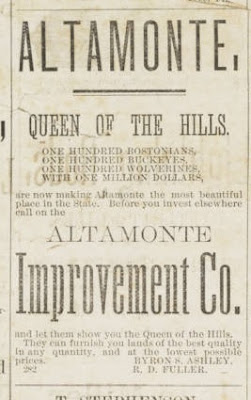50 States
of central Florida, Part 3:
Builders of America’s 19th century Paradise in
Florida arrived from nearly every corner of the world. Amazing pioneers,
dreamers and doers, they selected land locations in a wide swath of a Citrus
Belt stretching from the Atlantic Ocean to the Gulf of Mexico. A courageous
bunch of guys and gals, the pioneers came to Florida as well from parts of
every modern day State.
All 50 States played a role in founding central Florida, and
CitrusLAND will pay tribute to such remarkable individuals each Sunday
throughout the summer of 2018, doing so in the order States were admitted to
our Union of States. This week our spotlight shines on Massachusetts, State #6, admitted February 6, 1788; #7, Maryland,
admitted April 28, 1788, and South Carolina, admitted as State #8 on
May 23, 1788.
MASSACHUSETTS:
Orange County’s second post office, NEW SMYRNA was established June 5, 1845 by John D. SHELDON, a native of Massachusetts, the 6th State to be
admitted to our Union of States. Sheldon came to Florida Territory as a Customs
Inspector, met and married Jane MURRAY,
and together they worked to tame coastal Mosquito County. He served too as a
scout for the Army as they searched for waring Indians in the late 1830s. The
Sheldon’s opened a hotel, and later stood helplessly as it was bombed by the Union
Navy during America’s Civil War.
Many citizens of Massachusetts were active players in a developing
central Florida, including owners of the BOSTON
HERALD. The newspaper provided financing
for the first ever train to run from Sanford to Tampa, laying 22 miles of track
in 1880, from a new Sanford port at Lake
Monroe, to Orange County’s Seat at Orlando.
Two years later, Boston investors built a luxury hotel in the
midst of a 1,200 acre development they called ALTAMONTE (Photo above). From Newburyport came Thomas C. SIMPSON, representing the Boston investors,
and buying up dozens of homesteads. The hotel and cozy cottage sites later became
known as ALTAMONTE SPRINGS.
1884 Altamonte Advertisement
Retired Navy Secretary James M. ALDEN arrived in 1895,
acquiring South Orange County’s historic EPPES
residence on Lake Pineloch. The career Officer and Massachusetts native was
also an artist, and one of his paintings was of a dead tree, the famous COUNCIL OAK, said to be a gathering
place of the Seminole Indians. Alden’s presence and painting helped preserve an
important part of local history.
MARYLAND:
Born at Montgomery County, Maryland, Mary married William E. PATTERSON. Neighbor Fannie ROSS, schooled at Georgetown, Maryland,
married James FRANKLIN, a Navy Cadet
who was also a native of Annapolis. The two Maryland couples relocated in 1880 to the west shore of Lake Apopka.
Originally Sumter County, their two homesteads became part of Lake County in 1887.
Meanwhile, back at Georgetown Maryland, is a landmark known as
SUGARLOAF Mountain, and nearby is
the historic residence of MONTVIDEO.
Maryland Historical Society tells us the name of the home is Latin, meaning, “I see the MOUNTAIN.”
Montverde, Florida Railway depot
MONTVIDEO was one
of two residences owned by a Georgetown family. Their second residence, an even
older landmark, was called MONTANVERDE.
On Lake Apopka, James & Fannie FRANKLIN built a home, and began selling
parcels at a place they called, “Town of
MONTVERDE.” The Franklin’s could even see,
from their homestead, Lake County’s SUGARLOAF Mountain.
SOUTH
CAROLINA
South Carolina, the eighth state to join the USA, had been Florida’s-Mother
State. As early as 1803, South
Caroline plantation owner William WILLIAMS
the Elder, a British Loyalist, carved out SPRING
GARDEN Plantation, (presently Deleon Springs State Park in Volusia County,
1830s survey of Spring Garden is shown above). This was the very same site
owned by Colonel ORLANDO REES of South
Carolina in 1832, when John James Audubon visited the Colonel and drew of map
of the region (Below). Indians burned the Rees Plantation in 1836.
Map
drawn in 1832 by John James Audubon
The first survey of Fort GATLIN
region, south of Orlando, was completed in 1842
by a South Carolina native, Benjamin F. WHITNER.
Cousin Joseph N. WHITNER was
instrumental in developing the Fort REID
area. In between Gatlin and Reid, on ORLANDO’S
Lake Lucerne, South Carolina native Vincent LEE homesteaded 160
acres in 1842. Clearly, South
Carolina was well represented in the development of early central Florida.
Volusia County was carved from Orange County in 1854, while Florida Governor James E. BROOME, a South Carolina native, was still in office. Broome’s
final day in office coincided as well with the exact date of a deed conveyance
of four acres for an Orange County Courthouse site, a land donation made in 1857 by South Carolina Attorney, and
resident of Orange County, James G. SPEER.
Caldwell and Speer were both born in South Carolina. The first female Orange
County land tycoon, owner in 1860 of
1,700 central Florida acres, was, as
you guessed it by this point, a native of South Carolina.
Then too there is Orlando’s first Post Master, appointed in 1857. John R. WORTHINGTON was also born in South Caroline!
For more
on CitrusLAND and 19th century central FLORIDA:
Francis W. EPPES and the COUNCIL OAK are featured in my latest
book, awarded the 2017 Pine Castle Historian Award by Pine Castle Historical
Society: BEYOND GATLIN: a History of South Orange County. Learn more at my
Beyond Gatlin page at www.CroninBooks.com Also
check out First Road to Orlando –
chock full of early pioneers and their families.
Next Week: New Hampshire and Virginia





You mention many of the affluent people who migrated here, but what of the people with less means. The homesteaders whose cemeteries lie abandoned and any trace of their homestead gone.
ReplyDeleteMany of individuals I write about were not affluent. Jane Murray, for one, came to central Florida in the 1830s flat broke. This series will be featuring a variety of pioneers, rich and poor. Hope you enjoy.
Delete